Multi-use paths, bike lanes, speed humps, crosswalks and bike share, oh my!
By Ryan McGreal
Published September 26, 2014
It's been a busy year for active transportation infrastructure in Hamilton. Just over a month ago, I wrote about the Cannon Street Cycle Track (since opened), the weird strip of asphalt on Longwood Road South, bike lane detours for road work and a new crosswalk at Hunter and Locke.
It's not even a month and a half later, but I'm happy to report another batch of projects that has come down the pipe.
The Chedoke Golf Course multi-use path has been in the works for the past decade. Running along the north edge of Chedoke Golf Course, it connects the end of Glenside Avenue with Studholme Road just south of Aberdeen Avenue.
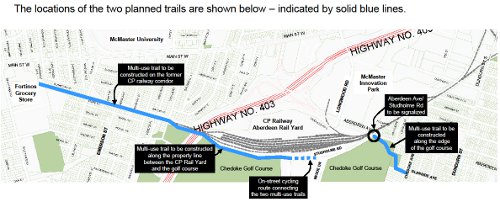
Map of the multi-use trail, marked in blue (click on the image to view full-size)
The multi-use trail across Hwy 403 has been open since 2011, but the section between Glenside and Studholme has been tied up with neighbours' complaints and environmental review tribunals. A fence around the path was proposed and then dropped along the way.
City staff have been working on the path for the past several weeks, digging, grading and paving the surprisingly wide path:
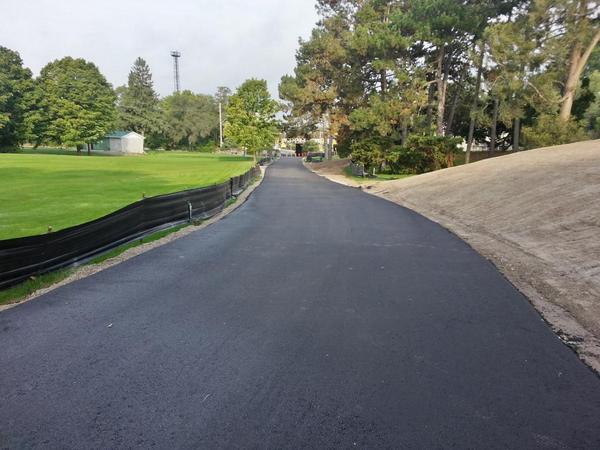
New paved multi-use path around north edge of Chedoke Golf Course
It replaces an 'unofficial' trail worn into the grass that wound more directly across the golf course between Glenside and Studholme.

Old unofficial path across Chedoke Golf Course (Image Credit: Ted Mitchell)
This is an important active transportation connection between southwest Hamilton and west Hamilton that lets people avoid the hostile conditions on Aberdeen and the half-assed bike path on Longwood.
Soon after the Cannon Street Cycle Track opened, city staff began work on bike lanes on York Boulevard between Hess Street and Dundurn Street. There are already bike lanes on Dundurn between York and King and on York west of Dundurn, so this was a vital connection to link those existing bike lanes together.
The good news is that there is a two-metre wide painted buffer between the bike lanes and the next adjacent automobile lane. Staff basically took a full driving lane in each direction and turned it into a buffered bike lane.

Buffered bike lane on York between Hess and Dundurn
The bad news is that the bike lanes will not be protected by any physical barrier. This is exasperating, especially given that the physically protected Cannon Cycle Track is right there. (The Cannon Cycle Track was designed by IBI Group, a third-party transportation consultant.)
By leaving the bike lanes unprotected, it becomes both easy and very tempting for drivers to park in the bike lane. This is an ongoing issue on Hunter Street, where the unprotected two-way bike lanes are routinely blocked by stopped and parked cars.

Vehicle parked in Hunter Street bike lanes
In contrast, I have yet to encounter a car stopped in the Cannon Cycle Track since it officially opened.
In yet another bizarre move, the City has decided to allow right-turning drivers on York to use the bike lane as a right turning lane.
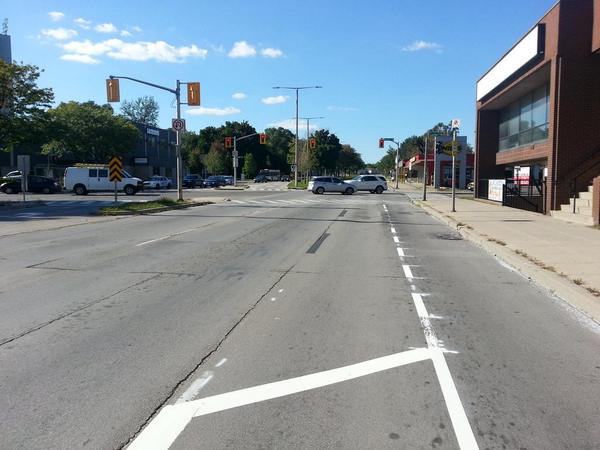
Cars are allowed to use York bike lane as right-turning lane
According to an email from Daryl Bender, the city's alternative transportation project manager, "This is regarded as a desirable design because it increases visibility and prevents bicycles from being side-swiped by right-turning auto traffic."
I guess those Dutch traffic engineers have been doing it wrong.
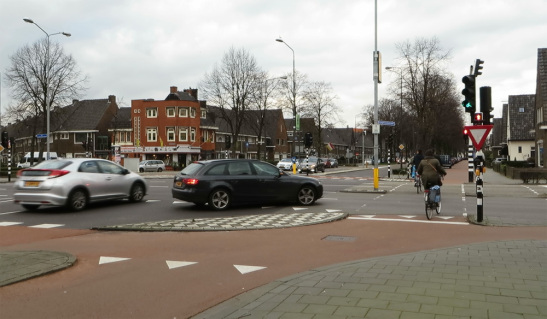
Dutch-style junction bike lane at an intersection (Image Credit: Bicycle Dutch)
And similar to the Cannon Cycle Track, where the planned pavement markings through intersections were inexplicably dropped from the plan before implementation, there are no pavement markings on York to make the bike lanes more visible through intersections.
Again, it is considered a best practice to increase the visibility of bike lanes at intersections, not to make them even less visible by removing even the painted buffer.
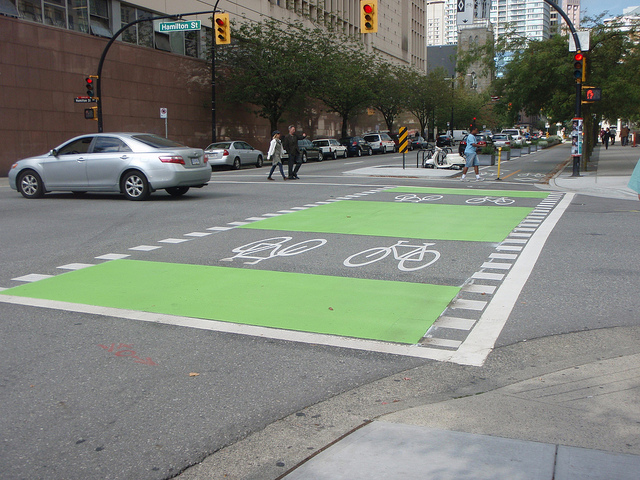
Intersection pavement markings on the Dunsmuir bike lane, Vancouver (Image Credit: Alexander Pope/Flickr, CC-BY-NC-ND)
Finally, there is no obvious way to get from the bike lane on York at Dundurn over to the Dundurn bike lane. The buffered lines continue right to the intersection with no way to get over to the left.

No obvious way to get from York bike lane to Dundurn bike lane
Presumably a cyclist is expected to dismount at Dundurn, cross York as a pedstrian, then get back on the bike and ride north on Dundurn.
It may seem that I'm just nitpicking here. After all, the bike lanes are a damn sight better than nothing and maybe I should just be grateful. For someone already riding a bike on York, the bike lanes are a dramatic improvement.
Here's the problem with that line of reasoning: a bike lane designed for people who are already riding bikes in mixed traffic will do very little to attract more people to choose cycling.
Traffic planners in Portland, Oregon found that there are four categories of people with respect to cycling:
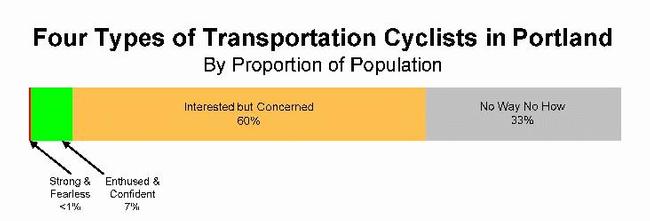
Four categories of transportation cyclists in Portland (Image Credit: City of Portland)
If the city's goal is to increase the number of people who choose cycling - and if that isn't the goal, I'm not sure why we even have a cycling office - then designing for people who already cycle amounts to yet another missed opportunity to build the kind of infrastructure that actually gets people cycling.
In contrast, I've cycled on Cannon Street a couple of times this week. On Tuesday evening, I rode from downtown to Sherman at around 7:30 PM and saw 14 people on bikes. On Wednesday around lunchtime, I rode the same way again and saw 20 people on bikes.
(These numbers may seem modest but a) it's still early days for Cannon and b) I've never seen anything like that many cyclists at a time on other streets.)
The cyclists ranged in age from kids 10-11 years old to people who looked quite elderly. I also saw several women cycling, which turns out to be very important.
Among transportation planners, women are regarded as an "indicator species" for the quality of infrastructure. A city with high quality infrastructure will have a more balanced ratio of male to female cyclists, not to mention a higher overall rate of cycling.
In contrast, when the cycling network is minimal or low-quality, the only people who will dare to ride a bike are a tiny, marginal outlier group of young, risk-seeking males - the "strong and fearless" category identified by the Portland planners.
These almost-good bike lanes we keep building are a false economy. It might save a bit of money to scrimp on paint and take a pass on knockdown bollards (they cost the city 80 bucks a pop), but we end up with lanes that just noodle around the margins instead of driving a real change in transportation choices.
Worse, irritated drivers point to under-used bike lanes as a waste of money. Through our fear of building really high quality bike lanes that would actually be used, we're setting ourselves up for failure.
Okay, time for something more more upbeat: the city has installed several speed humps around south Kirkendall. Speed humps appeared a few weeks ago on Glenfern between Undermount; two on South Street between Mountain and Dundurn, and two on Mountain between Aberdeen and Hillcrest.

Speed hump on Glenfern
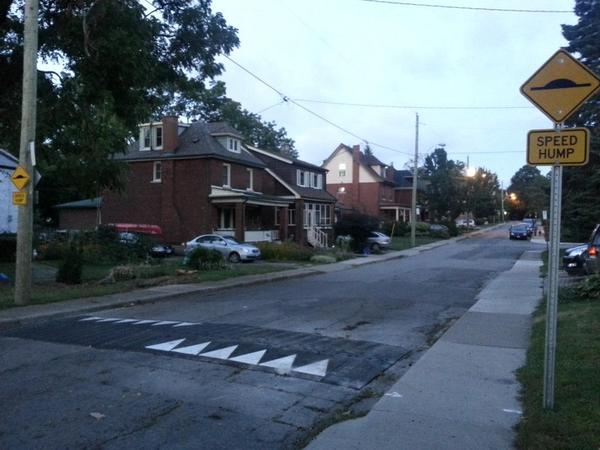
Speed hump on South Street
The speed humps are wide and not too tall. Cars have to slow down going over them but they make a fairly smooth ride. They are bolted onto the street so it looks like the City will be able to remove them during winter to avoid getting damaged by plows.
The new signalized crosswalk on Hunter at MacNab went into operation this past Wednesday. It includes a painted "zebra" or ladder crossing to make it more visible for drivers.
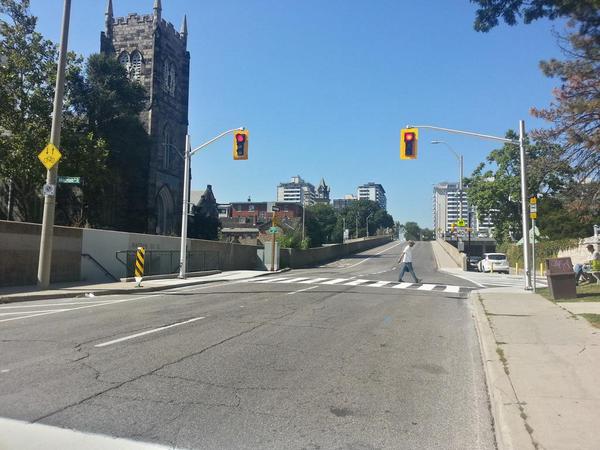
New crosswalk on Hunter at MacNab
Like the crosswalk that recently opened on Locke Street at Hunter, this was funded through the 2014 participatory budget process using the area rating capital fund.
There is one strange issue with this crosswalk that I have to mention: the traffic signal has a push-button for pedestrian activation, but it appears to be on a timed cycle between red and green.
I observed it in action for several minutes on Wednesday. The traffic lights turn yellow and then red and cars have to stop, even though no one is trying to cross.
Meanwhile, when a pedestrian does arrive they have to wait for a walk signal in the timed cycle before they can cross.
I have asked the City whether this is a mistake or a policy decision. It reminds me of the the new signalized crosswalk at Herkimer and Caroline, which was funded through the 2013 participatory budget process.
Despite the fact that the approved proposal was for a pedestrian-activated signal, the crosswalk was programmed for a timed cycle. It took months of complaints from residents before staff ended up changing it back to the button-activated design that was originally planned.
Last week, Hamilton Bike Share issued an update on the status of the bike share rollout. Short answer: the program isn't quite ready yet.
Apparently it takes a lot of time to establish a not-for-profit corporation, line up board members and staff, find and prepare a headquarters, order 750 bikes and 105 hub stations, solicit corporate and institutional sponsorships, set up a wireless data transmission system, equip the bikes with new technology, and install hub stations across the city.
Social Bicycles, the company that is supplying the bikes and technology for the bike share, is waiting for the wireless electronics on the bikes to be certified for use with Canada's cellular networks.
According to CEO Ryan Rzepecki in the news release, "We are in the final stages of product certification and will be entering into full production in the coming weeks."
Once the technology is certified, the bikes will start to roll out in a soft launch over the winter. The official ribbon-cutting is scheduled for March 20, 2015, the first day of spring.
For people who have already bought an annual membership, the clock won't start ticking on that year-long membership until the official launch but you will still be allowed to use the bikes for free during the winter.
In addition, the first month after opening will be free. This is true for anyone who buys a membership during the rollout phase between now and next March.
Meanwhile, the team has been busy for the past several weeks installing hub stations across a wide swath of the city.
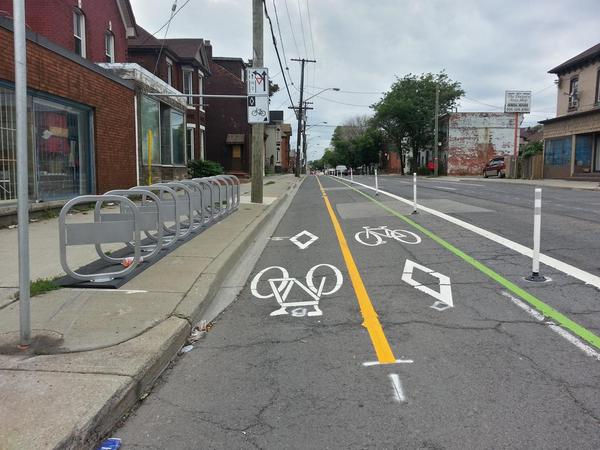
Bike share station at Cannon and Tisdale
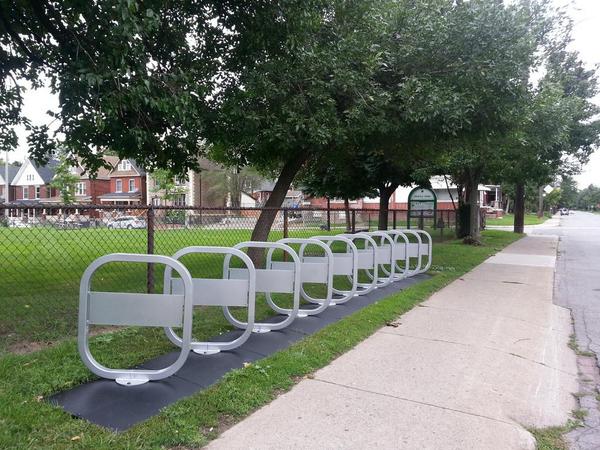
Bike share station at Delaware and Myrtle
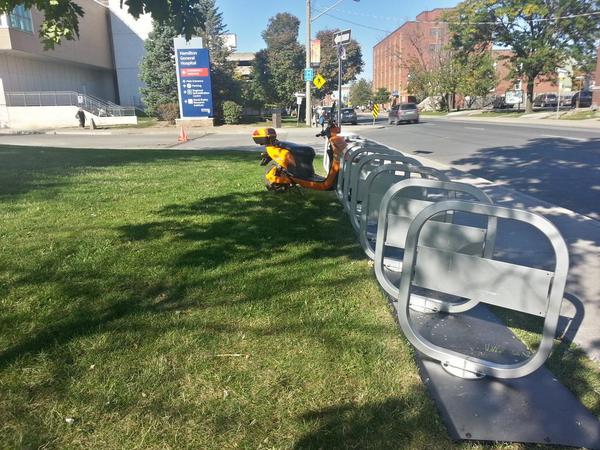
Bike share station at Hamilton General Hospital, Barton and Victoria
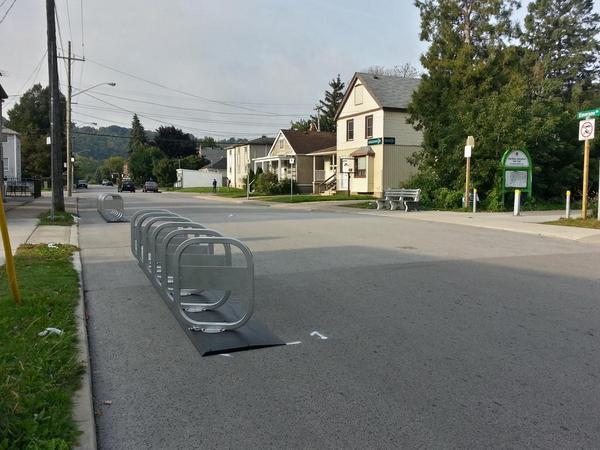
Bike share station on Emerson at the Rail Trail

Bike share station at King and Longwood, already in use as bike parking
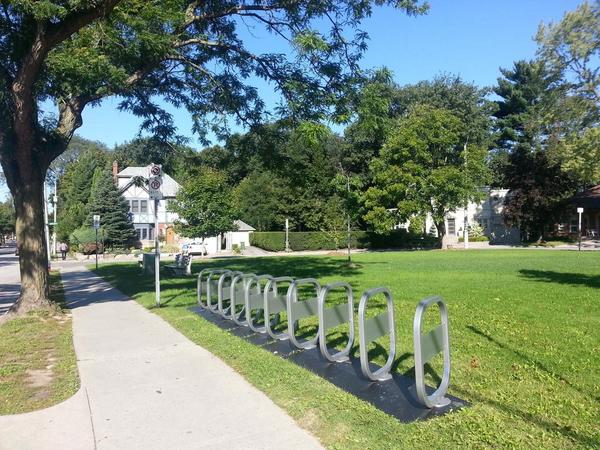
Bike share station at Sterling and Whitton
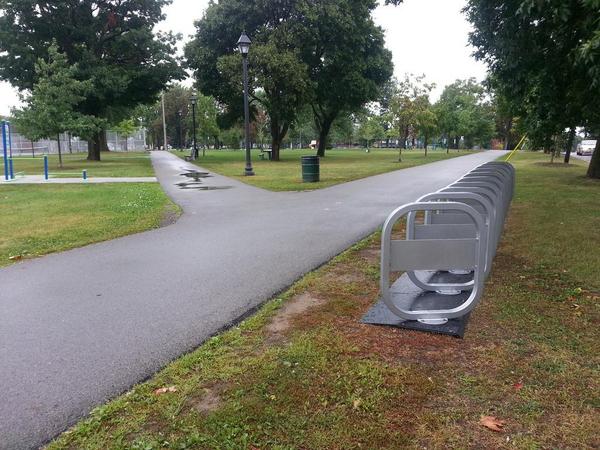
Bike share station at Victoria Park, Locke and Napier
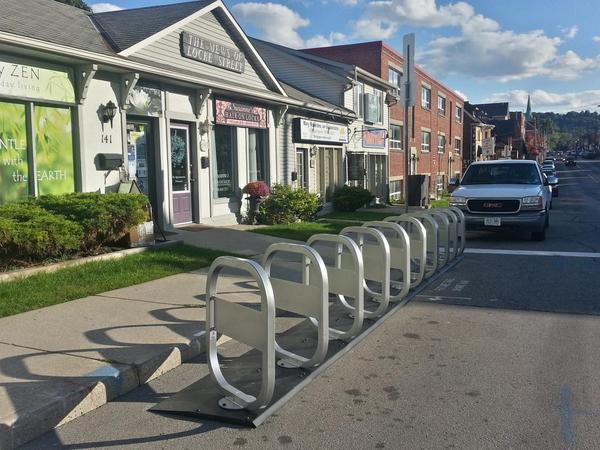
Bike share station at Locke and Hunter
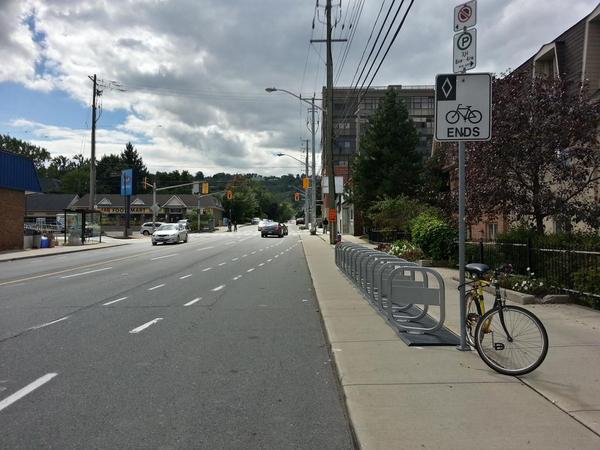
Bike share station at Dundurn and Aberdeen
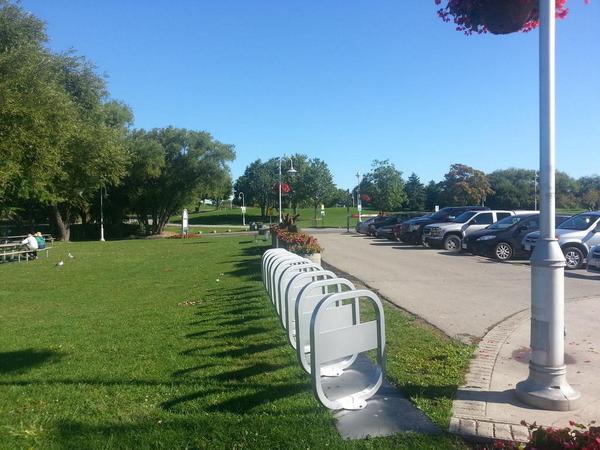
Bike share station at Bayfront Park (and there's another one at the top of the hill)
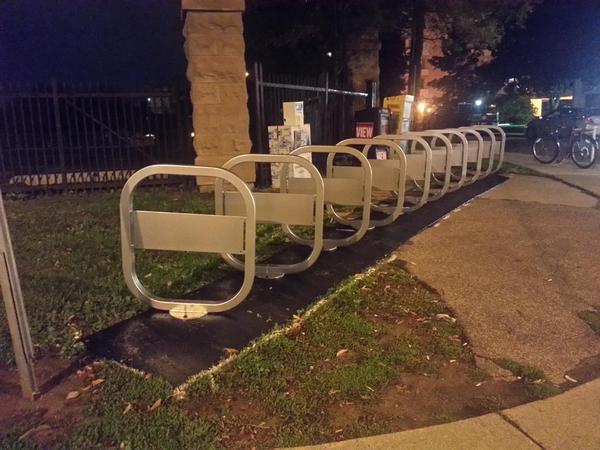
Bike share station at Bay and Bold
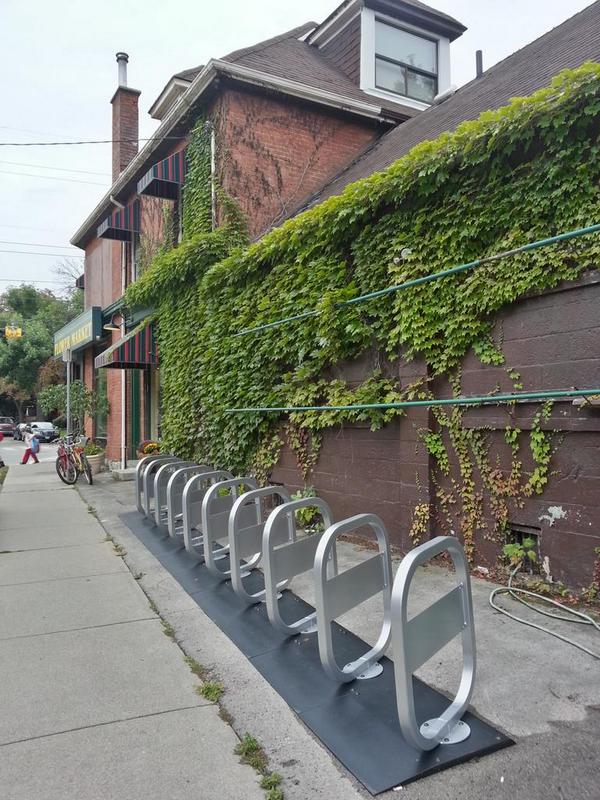
Bike share station at Charlton and Locke

Bike share station at the foot of Wentworth Stairs, Wentworth and Charlton
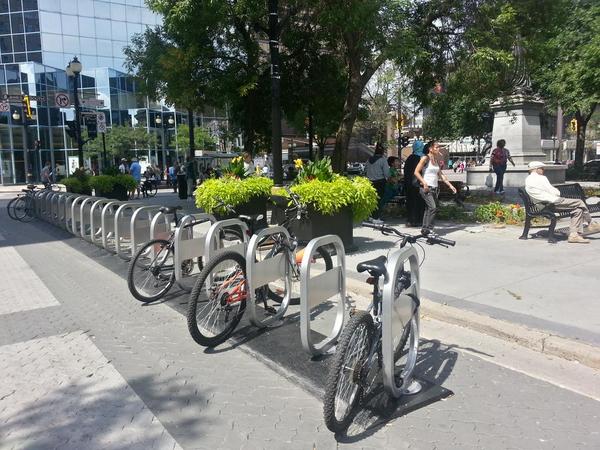
Bike share station at Gore Park, King and James, already in use as bike parking
More hubs are appearing on a daily basis as the map of hub stations is steadily filled in.
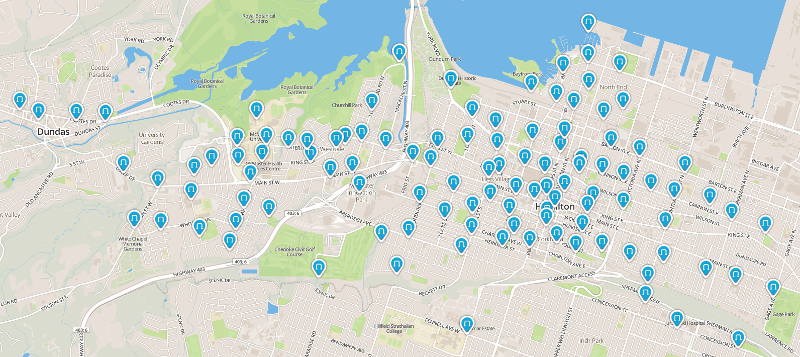
Map of Hamilton Bike Share hub stations (Image Credit: Hamilton Bike Share)
Hamilton Bike Share will be the tenth largest bike share system in North America. Despite the delays, it will be just a year from signing the deal with the City of Hamilton to full rollout. Most bike share systems take two or three years to come together.
By Grande (anonymous) | Posted September 26, 2014 at 09:13:30
As much as I'm happy about all these changes, we still don't have a friggin bike rack on Augusta St. There are *constantly* bikes there, chained up to fences, sign posts, and railings. I don't understand why they aren't there yet.
By the Letter Writer (anonymous) | Posted September 28, 2014 at 22:59:59 in reply to Comment 104869
The City is well aware of the Augusta Street parking shortage, and is absolutely interested in providing an on-street bike corral. They are hesitant because it will be a battle, so the more support people show for this simple project, the sooner it will be initiated.
By NoSugarAdded (registered) | Posted September 26, 2014 at 10:53:33 in reply to Comment 104869
Have you told the city/Councillor about this yet? They may not have a clue.
By John Neary (registered) | Posted September 26, 2014 at 10:49:22
I don't mean this comment as a criticism of Ryan -- he's the reporter, not the decider -- but I am disturbed by the continuing south/west end bias of Hamilton's active transportation improvements.
The Cannon St. cycle track is a huge step forward for the north-central part of our city, but it only happened after the biggest grassroots campaign Hamilton has ever seen regarding active transportation infrastructure. That's a tall hurdle to overcome.
The centre of mass of the bike share map is somewhere around Locke/Queen Street. There are more stations in Westdale (including McMaster) than in all of Ward 3, and no stations east of Gage.
Otherwise, we've got a paved path through a golf course in Kirkendall, bike lanes on York, speed humps in Kirkendall, and a crosswalk at Hunter and MacNab. That is, four projects in the south and west ends.
Hunter and MacNab certainly needed a crosswalk; it is 400 m between the pre-existing crossings of Hunter at James and Bay. It's also 600 m between the crossings of Cannon at Wentworth and Victoria (with no signalled crossing at Smith Avenue, on which St. Brigid School is located), and 500 m between the crossings of Main at Gage and King (opposite Gage Park).
Some justifications that will be proposed for this state of affairs will be "Wards 1/2 have better councillors", "The neighbourhoods in the south/west end have active neighbourhood associations who have been lobbying for these improvements for years", and "North/central/east end neighbourhoods have bigger priorities."
These arguments are a form of victim-blaming. The north/central/east end neighbourhoods have been treated as a sacrifice zone for generations, which has led to political disenfranchisement. That these neighbourhoods have other urgent issues should not be an excuse for deferring investment in their physical environment.
It is time for this city to commit to equity between neighbourhoods in its active transportation investments. This will require a catch-up period for neighbourhoods along King, Main, Cannon, and Burlington Sts. East.
By GrapeApe (registered) | Posted September 26, 2014 at 16:25:28 in reply to Comment 104873
John I agree with what you're saying -- except the victim part. if the city top-down imposed these changes then I can foresee similar opposite concerns that the money shouldn't be spent without consultation... As far as I am aware the improvements in Wards1/2 south-west are the result of community engagement in the budgeting process (http://www.forward1.ca/) of 1.5 million that goes to each lower city ward to "equalize" city taxes. Your concerns should be directed to your councillor on where the money is being spent.
By ergopepsi (registered) | Posted September 26, 2014 at 13:21:47
Does anyone know where the bike lane is going to be on Herkimer St? Will it be against the sidewalk or moved out to allow car parking? I wonder why the alleys weren't considered as they are much safer.
By the Letter Writer (anonymous) | Posted September 28, 2014 at 23:24:06 in reply to Comment 104876
The Herkimer/Charlton bike lanes will be away from the curb, adjacent to the parking lane. I can't remember if the parking lane is large enough to place that outside of the door zone.
By jason (registered) | Posted September 28, 2014 at 23:30:42 in reply to Comment 104937
Why are we still designing bike lanes like this? The bike lane should be protected by parking, not the other way around.
By jason (registered) | Posted September 26, 2014 at 16:44:35 in reply to Comment 104876
Im sure it will be in the door zone protecting the parking.
By GrapeApe (registered) | Posted September 26, 2014 at 16:27:11
Any idea if the city has considered how it will accommodate snow clearing in bike lanes? As I recall last year these lanes became snow storage -- it looks even more difficult to manage with the bike share racks sitting on some streets.
By KevinLove (registered) | Posted September 26, 2014 at 18:55:23
Note the incorrect use of "Shark's teeth" on the speed humps. These are used to indicate right of way, with traffic facing the teeth being required to yield right of way. But anyone facing the teeth will be riding on the wrong side of the road.
A proper example of correct use of Shark's teeth is currently seen at the intersection of Upper Wellington and Concession Street. And, of course, in the photograph of a Dutch intersection used in this article.
By Narayan (anonymous) | Posted September 28, 2014 at 22:52:58 in reply to Comment 104893
Those markings are not supposed to be sharks teeth, they are bump indicators, a similar-looking but unrelated symbol. Besides, the bumps are not crossings so there is no one to yield to anyway.
Even in the Netherlands, triangles have different meanings based on the direction. Right-side-up means "caution", while upside-down means "yield".
By KevinLove (registered) | Posted September 29, 2014 at 21:38:33 in reply to Comment 104935
"...a similar-looking but unrelated symbol."
Hilarious. Only here would "similar-looking" (to my eyes identical looking) symbols have different meaning.
By Narayan (anonymous) | Posted October 04, 2014 at 19:55:59 in reply to Comment 104961
Here, and literally all of Europe, and many other countries which unofficially follow or are inspired by the Vienna Convention on signage.
By KevinLove (registered) | Posted September 27, 2014 at 15:58:28
It occurs to me that the housing south of Studholme Road would be an excellent candidate for a car-free residential area. It is truly unfortunate that the citizens of Hamilton are being deprived of choice in housing.
Comment edited by KevinLove on 2014-09-27 16:01:31
By MattM (registered) | Posted September 29, 2014 at 20:02:42
Thought I'd add that there are also two new crosswalks in East Hamilton:
Neither have been completed and activated yet but the hardware and sidewalk cuts are in place. No idea if they will be getting ladder crosswalks (I'm betting they won't since the farthest East I've seen them paint one is Province and Cannon).
Comment edited by MattM on 2014-09-29 20:04:47
By John Neary (registered) | Posted September 30, 2014 at 09:23:35
That's great news. I hope we'll see more; there's a lot of catching up to do in the east-end neighbourhoods.
By jason (registered) | Posted October 06, 2014 at 18:44:28
Meanwhile in Syracuse NY
You must be logged in to comment.
There are no upcoming events right now.
Why not post one?